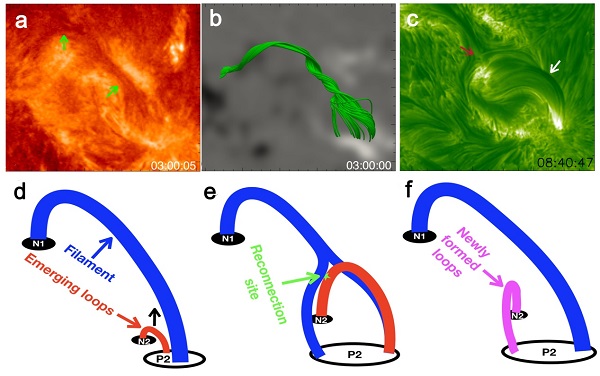The solar filaments are composed of relatively cold and dense plasma suspended in the corona through a complex magnetic field system. It is generally believed that the filament mass comes from the chromosphere. However, it is unclear how the filament mass is transported to the corona and what is the magnetic field structure. The shear and convergence motions of the polarities under the filament are often observed, which may suggest that magnetic reconnection plays a very important role in the formation of the filament.
Magnetic reconnection is a physical process in which two sets of magnetic field lines in opposite directions approach each other and reconnect, accompanied by the rapid release of magnetic energy. The Sun is an excellent candidate to investigate magnetic reconnection, since most of solar eruptions are related to magnetic reconnection. However, observational events on magnetic reconnection are rarely reported since it is small-scale and difficult to observe.
Dr XUE Zhike et al. studied the reconstruction of a solar filament caused by magnetic emergence and magnetic reconnection on 2021 June 4, mainly using the high-resolution data obtained by the 1-meter New Vacuum Solar Telescope (NVST) at the Fuxian Solar Observatory of Yunnan Observatories, the Chinese Academy of Sciences (CAS), the Solar Dynamics Observatory (SDO) and the Interface Region Imaging Spectrograph (IRIS). The results have been published recently in The Astrophysical Journal.
The right leg of the filament initially shows a spread-out structure (Figure 1a), and confirmed by the extrapolated 3D magnetic structure (Figure 1b). Many small positive and negative magnetic polarities and magnetic loops gradually emerge near the magnetic polarity of the filament’s right footpoint (the white arrow in Figure 1c). During this process, the right leg of the filament is then split into two parts, while its left leg still maintains a whole structure. Meanwhile, the newly emerged magnetic loops gradually rise upwards between the splitting parts. A small-scale magnetic reconnection occurs between the newly emerged magnetic loop and the magnetic fields supporting the southeastern splitting part (the red arrow in Figure 1c). The longer magnetic loops resulting from the reconnection merge with the magnetic fields of the other part of the split filament part, and thus reforming an entire filament.
The observational results reveal that magnetic emergence is responsible for splitting of the filament, while magnetic reconnection leads to the reconstruction of the filament (Figure 1d-f).

Figure 1. (a) SDO 304 Å image with the green arrow pointing to the filament. (b) Extrapolated 3D magnetic structure. (c) NVST Hα image, in which the newly emerged loops and magnetic reconnection site are indicated by the white and red arrows, respectively. (d-f) Cartoons showing the process of magnetic emergence (red curves), splitting and reconstruction of the filament (blue curves), magnetic reconnection (green arrow).
Contact:
XUE Zhike
Yunnan Observatories, CAS
Email: zkxue@ynao.ac.cn